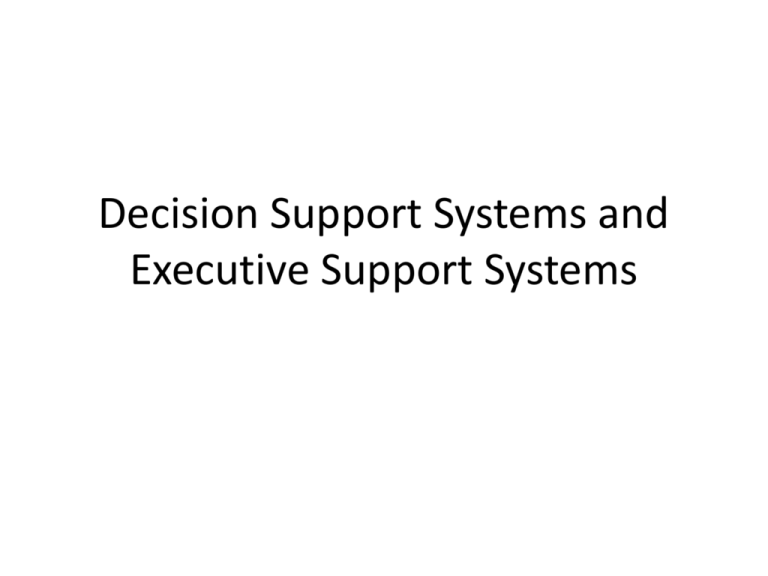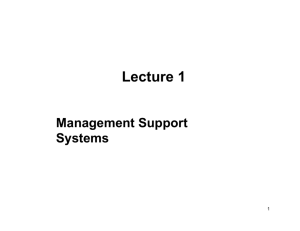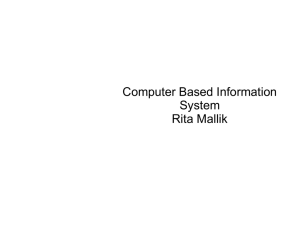Decision Support Systems and Executive Support Systems
advertisement

Decision Support Systems and Executive Support Systems Management decisions/problems • • Most management problems for which decisions are sought can be represented by three standard elements – objectives, decision variables, and constraints. These problems can be structured, semi-structured and unstructured in nature: • Objective • Decision variables • Constraints – Maximize profit – Provide earliest entry into market – Minimize employee discomfort/turnover – Determine what price to use – Determine length of time tests should be run on a new product/service – Determine the responsibilities to assign to each worker – Can’t charge below cost – Test enough to meet minimum safety regulations – Ensure responsibilities are at most shared by two workers • Is there any connection between the above and strategic formulation (the strategic formulation process.) Structured • Structured decisions are those which are made according to specified procedures of rules or structured decisions are those that are easily made from a given set of inputs. – Deciding to send a reminder notice to a customer for an overdue balance is considered to be structured decision Semi-structured • Semi-structured decisions are those for which information obtained from a computer system or information system is only a portion of the total knowledge (information) needed to make decision. – Advertise a new product – how much to spend on MIS. Unstructured • Unstructured decisions are novel. • There is no cut and dried method for handling the problem because it is novel, it's precise nature and structure are complex, • These, types of decisions often , involve a high degree of freedom- many ways to try and solve the problem. • They may require a lot of creativity and intuitions from the decision maker to tell what factors will come into play in an unstructured play. Decision support systems • A Decision Support System (DSS) is an interactive computer-based system or subsystem intended to help decision makers- use information systems (data, computational processing and output (report) - identify and solve problems and make decisions. • Decision Support System is a general term for any computer application that enhances a person or group’s ability to make decisions; can be as simple as an excel spread sheet to a complicated system involving large databases, statictical modelling techniques and applying A.I. to dervive information. Information Systems to support decisions Management Information Systems Decision Support Systems Decision support provided Provide information about the performance of the organization Provide information and techniques to analyze specific problems Information form and frequency Periodic and exception reports Interactive enquiries and responses Information format Prespecified, fixed format Ad hoc, flexible, and adaptable format Information processing methodology Information produced by extraction and manipulation (basic analysis) of business data Information produced by analytical modeling of business data (see next lecture) Definition of decision support system • Decision Support Systems (DSS) are a specific class of computerized information system that supports business and organizational decisionmaking activities. Examples of their use Typical information that a decision support application might gather and present would be: • Gather information by: – Accessing all of your current information assets, including legacy and relational data sources, cubes, data warehouses, and data marts • Present information: – Comparative sales figures between one week and the next – Projected revenue figures based on new product sales assumptions – The consequences of different decision alternatives, given past experience in a context that is described Making decisions • Four stages of making decisions 1. Intelligence 2. Design 3. Choice 4. Implementation Please note the close similarity to the strategic formulation/implementation and evaluation framework Intelligence (find what to fix) Find or recognize for example: a problem, a requirement, or opportunity. • Consistent customer requests for new-product features • The threat of new competition • Declining sales • Skyrocketing costs • An offer from a company to handle your distribution needs, and so on Design (find solutions) • Consider possible ways of: – solving the problem, – filling the need requirement, – taking advantage of the opportunity. • In this phase, you develop all the possible solutions you can. Choice a solution Examine and weigh the merits of each solution, estimate the consequences of each, and choose the best one. Using factors such as: • Cost • Ease of implementation . • Staffing requirements • Time to implement solution This is the prescriptive phase of decision making Implementation (apply the fix) • Carry out the chosen solution, • monitor the results, and make adjustments as necessary (evaluation and modification of solution) • Simply implementing a solution is seldom enough. Your chosen solution will always need fine-tuning, especially for complex problems or changing environments. Basic Functions of DSS • Data/Information retrieval • Data reconfiguration • Calculator activities (computational processing of the reconfigured data) Information retrieval • Information retrieval in DSS environment refers to the act of extracting information from a database for the purpose of making decisions. Usually, the sequence of retrievals made by the user is unanticipated. – For example, the manager may see a few startling pieces of information on the display and, as a result of these, suddenly produce a report that provides more detail about the situation: Drill down Data reconfiguration • Often managers using a DSS want information in a form other that that in which the data is logically represented within the computer system • The ability to reconfigure data makes it possible for managers and other decision makers to look at existing data from alternative perspectives: the use of online analytical processing and data warehouse is clearly quite helpful for this DSS functionality. Calculator activities • Business (mathematical) Functions – Functions : profit = sales – costs; costs = production…. • Analysis: Analysis refer to using a decision support system (DSS) to review a set of facts and to assist in drawing conclusions based on there facts. – Statistical Tools: regression and correlation analysis – Optimizing tools – What if analysis (sensitivity analysis) Optimizing tools • Optimizing tools are useful for deriving the best solution in certain structured decisions usually at tactical and operational levels. • Optimizing tools are used where it is required to optimize the value of a single objective (e.g. production capacity) where the factors invoked (e.g. labour hours, machine capacity etc.) are subject to some constraints or limitation. Optimizing tools solve problem which • • • • Can be stated in numerical terms. All factors have linear relationships. Permit a choice between alternatives. Have one or more restrictions on the factors involved What if analysis (sensitivity analysis) • Assessing risk with the help of DSS tools is known as sensitivity analysis. • One object of sensitivity analysis is to identify the "Critical" or "Sensitive" variables, which are those variables which have a more than proportionate effect on the result. • At its simplest this means, holding all the variables, bar one, constant and altering that one variable step by step and noting the effect on the result. – A simple example a simulation to determine profit. Depends on cost per unit, price per unit, volume of units sold… – What if price per unit is increased by 0% & 1/2%, 2% or minus 1% etc. what effect would it have on profit. Using a DSS for the supply chain • A DSS can give a Comprehensive examination of supply management chain • Searches for most efficient and cost-effective combination. Normally the most efficient is not always the most cost effective • Reduces overall costs • Increases speed and accuracy of filling customer orders DSS for Customer Relationship Management • Uses data mining to guide decisions • Consolidates customer information into massive data warehouses • Uses various analytical tools to slice information into small segments; e.g. using OLAP software DSS for customer analysis and segmentation Executive support systems (ESS) • Senior managers use a category of information systems called executive support systems (ESS) to make decisions. • They address unstructured decisions and create a generalized computing and communications environment rather than providing any fixed application or specific capability Executive Support Systems (ESS) features • Tailored to individual executives – Not to managers in other levels • • • • • • • Easy to use Drill down capabilities Support need for external data Future-oriented Linked to value-added processes (business process) Track critical data from these business processes Ensure the data/information is available quickly and when required Capabilities of Executive support systems (ESS) • ESS is designed to incorporate data about external events such as new tax laws or competitors, but they also draw summarized information from internal MIS and DSS. • They filter, compress, and track critical data (sales data), emphasizing the reduction of time and effort required to obtain information useful to executives. • ESS employs the most advanced graphics software and can deliver graphs and data from many sources immediately to a senior executive's. • What software/technology could be used to facilitate these capabilities. Sample questions answered by ESS • What business should we be in? • What are the competitors doing? • What new acquisitions' would protect us from cyclical business swings? • Which units should we sell to raise cash for acquisitions? Question • Distinguish between structured, semi-structured and unstructured decisions. (6 marks) • What are the essential features of a decision support system. (12 marks) • Explain, using suitable examples, How can these features help solve semi-structured and unstructured decisions. (12 marks) • An Executive information systems is designed to solve unstructured problems. Distinguish between this system and the DSS. (6 marks) Exam Question • What are the four steps in a decision making process. (8 marks) • What are the three features of a decision support system. (12 marks). • Explain how these features can be used to help implement strategies that require a tighter integration with an organisations suppliers and customers. (10 marks)





